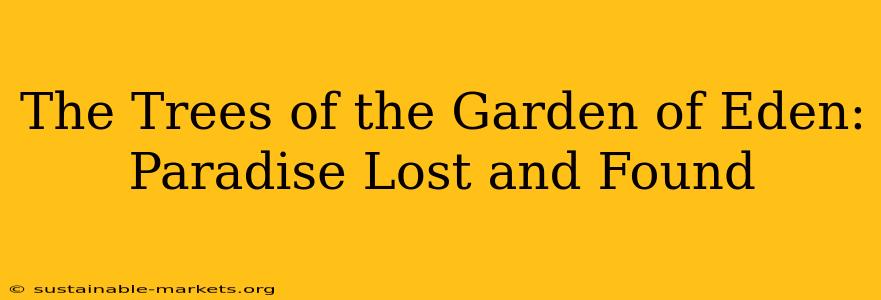The Garden of Eden, a mythical paradise described in the Book of Genesis, holds a timeless fascination. Central to its imagery are the trees, imbued with profound symbolic meaning and playing pivotal roles in the narrative of humanity's fall and potential redemption. This exploration delves into the significance of the trees within the Garden, examining their symbolic weight and interpretations across religious and literary traditions. We'll uncover the mysteries surrounding the Tree of Life and the Tree of the Knowledge of Good and Evil, exploring their enduring impact on our understanding of paradise lost and, perhaps, paradise found.
What are the two main trees in the Garden of Eden?
The two most prominent trees in the Garden of Eden are the Tree of Life and the Tree of the Knowledge of Good and Evil. These trees are not simply botanical features; they represent fundamental aspects of existence, mortality, and the human condition. The Tree of Life symbolizes immortality and divine connection, offering eternal life to those who partake of its fruit. Conversely, the Tree of the Knowledge of Good and Evil represents the acquisition of knowledge and self-awareness, leading to both understanding and the consequences of choice.
What is the significance of the Tree of Life?
The Tree of Life holds immense symbolic weight. It represents immortality, divine grace, and the unbroken connection between humanity and God before the Fall. Its fruit grants eternal life, signifying a state of perfect communion with the divine. Across various cultures and religious traditions, similar symbols of life-giving trees appear, suggesting a universal archetype of abundance and renewal. The Tree of Life's exclusion from humanity's reach after the Fall underscores the consequences of disobedience and the loss of paradise.
What is the significance of the Tree of the Knowledge of Good and Evil?
The Tree of the Knowledge of Good and Evil represents self-awareness, moral consciousness, and the capacity for independent thought and choice. While seemingly positive, its fruit carries the consequence of understanding both good and evil, leading to a separation from the divine and the experience of suffering and mortality. Partaking of its fruit represents humanity's transition from innocent ignorance to conscious awareness, marking the beginning of both our intellectual and moral development and our separation from the idyllic innocence of the Garden.
What happens after eating from the Tree of Knowledge of Good and Evil?
Eating from the Tree of the Knowledge of Good and Evil results in the expulsion of Adam and Eve from the Garden of Eden. This expulsion signifies the loss of innocence, immortality, and direct communion with God. They gain knowledge and self-awareness, but at the cost of paradise. This narrative is interpreted as representing the human condition – the bittersweet acquisition of consciousness and the inherent consequences of choice and free will. The act also introduces mortality, labor, and the complexities of human relationships into their existence.
Is there a Tree of the Knowledge of Good and Evil in the Bible?
Yes, the Tree of the Knowledge of Good and Evil is explicitly mentioned in Genesis 2:9 and 3:1-24. This tree serves as the central element in the narrative of the Fall, representing the forbidden knowledge that leads to humanity's expulsion from Eden. Its presence is crucial to understanding the biblical account of creation, sin, and the consequences of disobedience.
What is the meaning of the Garden of Eden?
The Garden of Eden symbolizes a state of perfection, innocence, and harmony with nature and God. It represents an idyllic existence prior to human sin and suffering. Its loss reflects the human condition: our longing for paradise and the consequences of our choices. Interpretations of Eden vary across religious and philosophical viewpoints, but it consistently symbolizes a lost golden age, a yearning for a simpler, more harmonious existence.
Conclusion: A Continuing Search for Paradise
The trees of the Garden of Eden, particularly the Tree of Life and the Tree of the Knowledge of Good and Evil, remain potent symbols that continue to resonate throughout religious, literary, and artistic traditions. Their representation in Genesis offers a powerful narrative about humanity's origins, our relationship with God, and the enduring quest for meaning and purpose in a world marked by both knowledge and the experience of loss. The story serves not only as a cautionary tale but also as a reflection on the human condition and our ongoing search for a renewed sense of paradise, whether literal or spiritual.

